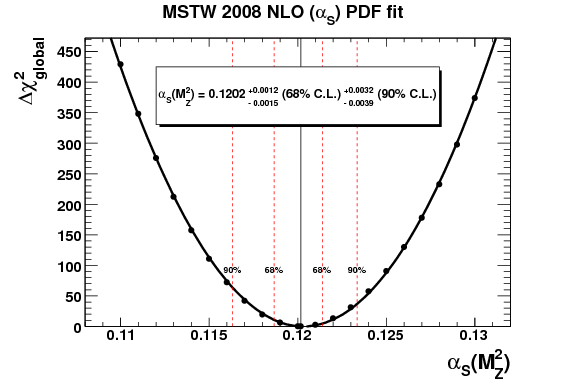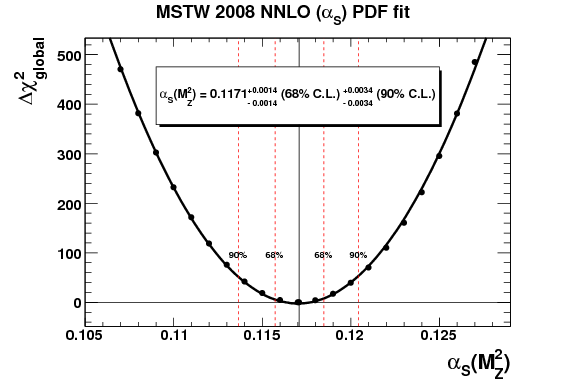|
|
MSTW PDFs : PDF sets for different αS values
Here we provide additional PDF grid files associated with the paper:
A. D. Martin, W. J. Stirling, R. S. Thorne and G. Watt,
“Uncertainties on αS in global PDF analysis and implications for predicted hadronic cross sections”,
Eur. Phys. J. C 64 (2009) 653-680 [arXiv:0905.3531 [hep-ph]].
Please reference this paper if you use these PDF grids for a publication.
We provide NLO grids with αS(MZ) in the range 0.110 to 0.130, and NNLO grids with αS(MZ) in the range 0.107 to 0.127, in steps of 0.001 in each case, i.e. 21 different values of αS(MZ) at each order. The best-fit αS values are given in the plots below, together with their 68% and 90% confidence-level (C.L.) limits:


We then generate grids for the best-fit PDF sets, and 40 associated eigenvector PDF sets to allow the calculation of PDF uncertainties, for fixed values of αS(MZ) shifted to each of the limits (and to half these limits) shown in the plots above. Together with the code and grids for the best-fit αS(MZ), a “PDF+αS” uncertainty can be calculated on any observable such as a hadronic cross section. We give example code below which calculates the “PDF+αS” uncertainty for the leading-order total cross section for Higgs production via gluon-gluon fusion at the Tevatron and LHC. See the above-mentioned paper for more details. A discussion of the precise αS definition used, and a comparison with the definition previously used by the MRST group, can be found in the Appendix of that paper (Fortran code for αS is available in alphaS.f, which is also used in LHAPDF).
Additional grids for standalone code
- First make sure you have the standalone interpolation code and grids for the best-fit αS(MZ), provided with the earlier MSTW 2008 paper. (Note that, as commented on at the bottom of the README file, a minor update to the code and grids was made on 22nd January 2009 where an additional variable “alphaSnfmax” was added to the header of the grid files. This updated interpolation code is required to read the additional grids below.)
- Download the following additional files into the “Grids/” directory.
- Unpack each file into the “Grids/” directory with e.g. tar zxvf filename.tar.gz.
- An example program ggh_mstwpdf.f illustrates the use of the additional grids. Compile by linking to mstwpdf.f and alphaS.f. The example program is only provided in Fortran. However, the additional grids can be used just as well with either the Fortran, C++ or Mathematica interpolation code.
Additional grids for LHAPDF V5.7.0
- First make sure LHAPDF (version 5.7.0) is installed. This already includes the best-fit αS PDF sets from the earlier MSTW 2008 paper. (Get the MSTW 2008 grid files for the best-fit αS here.)
- Download the following additional files into the “share/lhapdf/PDFsets/” directory. (Find it with e.g. lhapdf-config --pdfsets-path.)
- Unpack each file into the “share/lhapdf/PDFsets/” directory with e.g.
gunzip MSTW2008nlo_asmzrange.LHgrid.gz; gunzip MSTW2008nnlo_asmzrange.LHgrid.gz
tar zxvf MSTW2008nlo_asmzeig.tar.gz; tar zxvf MSTW2008nnlo_asmzeig.tar.gz
No recompilation of the LHAPDF library should be necessary. (Note that LHAPDF V5.7.0 expects to read in 41 PDF sets for each of the .LHgrid files in the “MSTWgrid” format. Therefore the MSTW2008nlo_asmzrange.LHgrid and MSTW2008nnlo_asmzrange.LHgrid files, each comprising only 22 PDF sets, have been padded with an additional 19 PDF sets consisting only of zeros, to avoid modifying the LHAPDF V5.7.0 source code.)
- An example program ggh_lhapdf.f illustrates the use of the additional grids. Compile by linking to the LHAPDF library in the usual way.
Update (16th July 2009): The additional grid files are now included in LHAPDF V5.7.1. The zero-padding has been removed from MSTW2008nlo_asmzrange.LHgrid.gz and MSTW2008nnlo_asmzrange.LHgrid.gz.
Comments to Graeme Watt <Graeme.Watt(at)cern.ch>.
|

